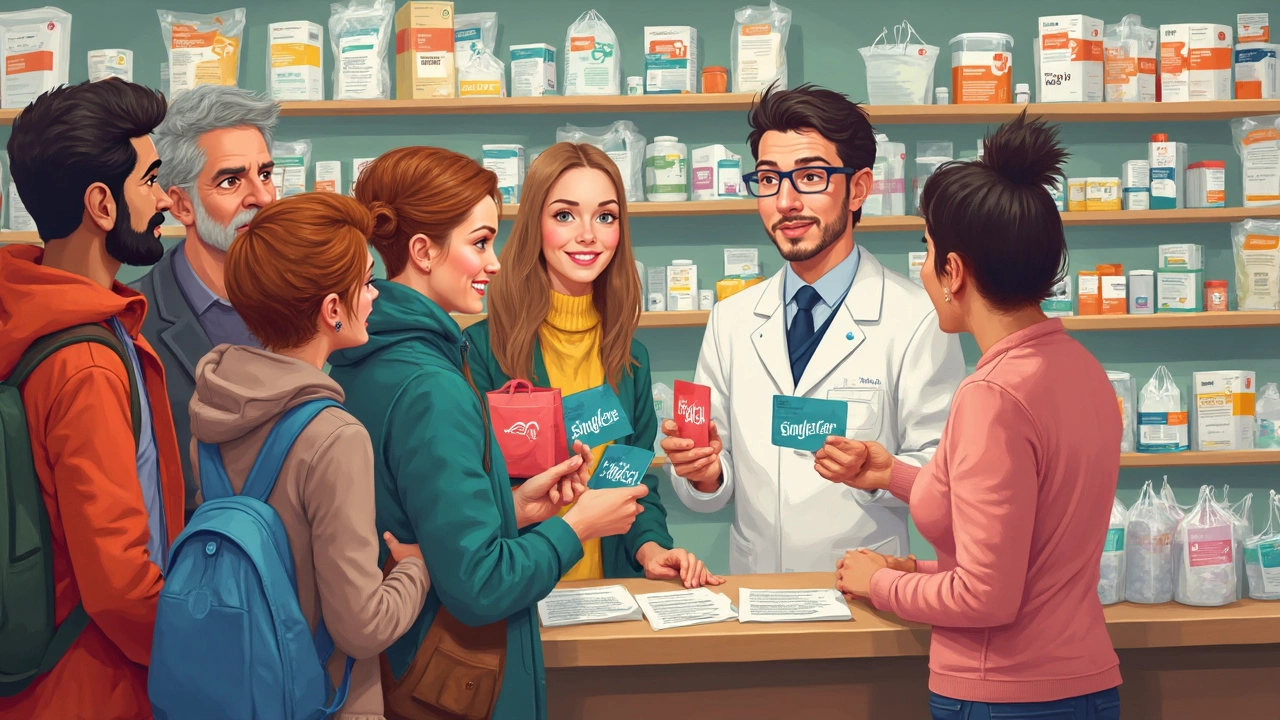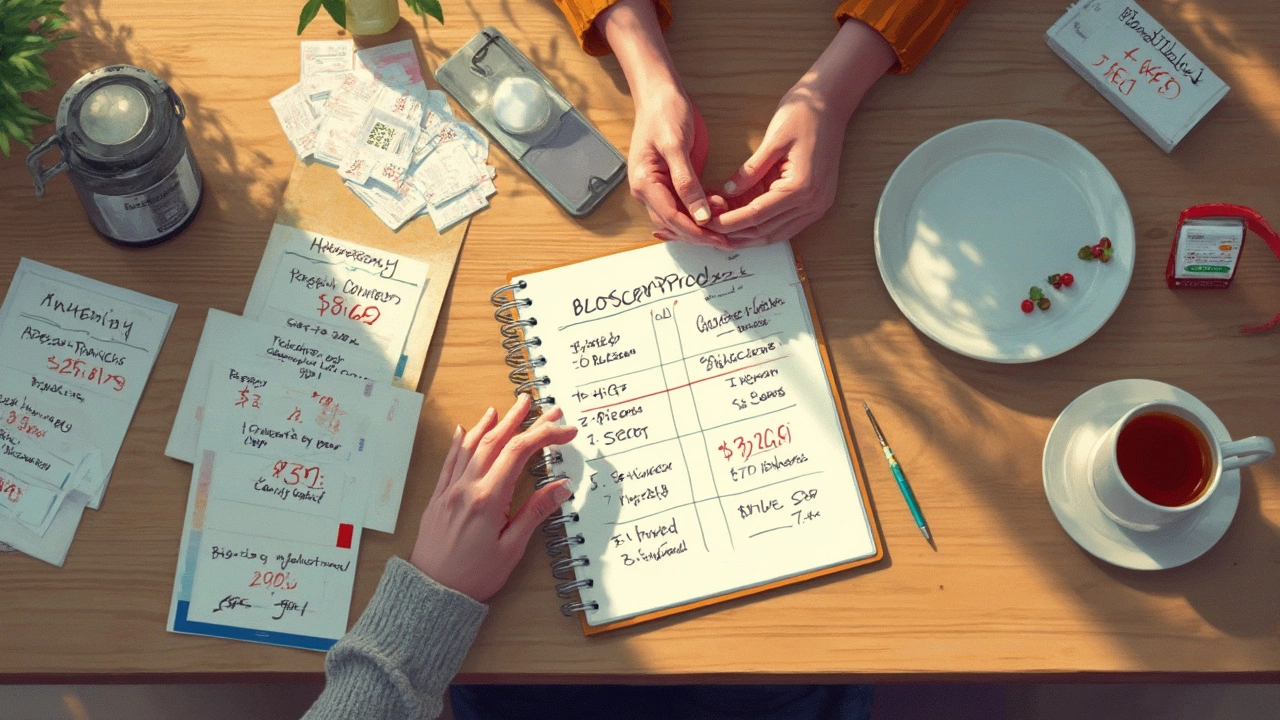 Jun, 2 2025
Jun, 2 2025
Sticker shock at the pharmacy counter happens to everyone at some point. Before you just hand over your credit card and hope for the best, there’s an easy move: check if SingleCare or GoodRx can slash that price down. These discount programs are free, and they aren’t insurance—they just help you pay less, sometimes a lot less, for the exact same meds.
But is SingleCare or GoodRx cheaper? That depends on the drug, the pharmacy, and even the zip code. Sometimes the difference is just a few bucks. Other times, you’ll see savings of over fifty dollars on a single refill. There’s no set winner, and that’s where people get tripped up—just picking one and hoping for the best.
If you’ve never used one of these cards before, here’s what’s wild: you just look up your medicine on their app or website, find the lowest price in your area, and show the code to the pharmacist. That’s it. You don’t have to switch pharmacies or sign up for a new plan. And honestly, if you’re on the hook for a high deductible, or if a med isn’t covered by your insurance, these cards can be better than your regular plan’s price.
- How SingleCare and GoodRx Work
- Comparing Actual Prescription Prices
- When One Option Saves More Than the Other
- Tips to Maximize Your Prescription Savings
How SingleCare and GoodRx Work
Ever wonder why drug prices seem random, even for the exact same pills? That's where discount programs like SingleCare and GoodRx come in. Both work a bit like secret shopping hacks—they team up with pharmacy networks to negotiate lower prices, then share those savings with you through free cards, codes, or printable coupons.
- SingleCare: No membership needed. It’s basically a free price-comparison tool for meds. You search your drug online or with the app, see the price at local pharmacies, pick the best deal, and show your SingleCare coupon to the pharmacist. They ring it up, and you pay the SingleCare price. SingleCare runs on a big network—over 35,000 pharmacies in the U.S., including CVS, Walmart, Walgreens, and even some local shops.
- GoodRx: Works almost the same way—search for your med, compare prices, show the coupon at the counter. GoodRx partners with over 70,000 pharmacies nationwide, giving you an even wider reach. They also offer a paid Gold membership for people who take a lot of meds, but for most, the basic free version is just fine.
You don’t need to hand over any personal health info—just look up your prescription by its name and dosage. Both programs show real-time pricing, so you’re seeing what you’d actually pay at the register. Here’s a quick look at some important at-a-glance facts:
| Feature | SingleCare | GoodRx |
|---|---|---|
| Network Size | 35,000+ pharmacies | 70,000+ pharmacies |
| Membership Fee | None | None (Gold: $9.99/mo) |
| Features | Mobile app, rewards, free coupons | Mobile app, premium Gold option, free coupons |
| Insurance Needed? | No | No |
One tip: You don’t have to stick with just one card. It’s totally fine to shop both SingleCare and GoodRx at the counter and see which deal the pharmacy will give you—some people literally pull up both apps on their phone and ask the pharmacist to check. That way, you know you’re getting the rock bottom price every time.
Comparing Actual Prescription Prices
Everyone wants to know which card will actually get you the lower price at the pharmacy. Here’s the thing—prescription prices can jump all over the map, even from one block to the next, and the same goes for deals from SingleCare and GoodRx. For example, as of early 2025, a 30-day supply of generic Lipitor (atorvastatin 20mg) might show up as $15.20 with SingleCare at CVS, but just $11.60 with GoodRx down the street at Walgreens. Switch to amoxicillin? SingleCare shows $8.50 at Rite Aid, but GoodRx lists it for $10.05 at the same spot. The winner flips depending on the med and pharmacy.
One thing to know: the SingleCare price can sometimes beat GoodRx by a good margin for less common meds. Take Synthroid (levothyroxine): you might see SingleCare at $11 for a 30-day generic at supermarket pharmacies, while GoodRx can jump to $14 or more at chains like CVS. But for common ones, like metformin, GoodRx often holds a slim lead, knocking 50 cents or a buck off what SingleCare posts. Either way, you want to compare the two every single time—there’s no ‘one always wins’ situation.
The prices you see online are real, but always double-check with the actual pharmacy. Pharmacies update deals and prices almost daily, and there’s the occasional mismatch between app and counter (usually, they fix it if you show them the code from your phone).
- Always check both websites or apps before refilling anything: it takes two minutes and could save you $40 or more each month if you’re on long-term meds.
- If you find a lower price at a different pharmacy, see if your local spot will match it—some will, but you have to ask.
- The easiest way to keep track: screenshot the prices so you can show them right at the counter.
This back-and-forth may seem like a hassle, but when it comes to real cash out of your pocket, it’s worth the extra look. You’d be surprised how often the cheaper card changes depending on the smallest details.

When One Option Saves More Than the Other
There’s no magic answer because SingleCare and GoodRx play by different rules with pharmacies. Sometimes GoodRx gets a better deal at CVS, while SingleCare might have the edge at Walgreens or Rite Aid. Their contracts are separate, so the lower price jumps back and forth depending on where you shop and what you need.
Let’s look at real numbers from May 2025 for three common meds. Prices may bounce around a little, but this gives a solid clue:
| Medication | Pharmacy | GoodRx Price | SingleCare Price |
|---|---|---|---|
| Atorvastatin 20mg (30 tablets) | CVS | $15.22 | $11.58 |
| Metformin 500mg (60 tablets) | Walgreens | $9.37 | $13.09 |
| Sertraline 50mg (30 tablets) | Walmart | $10.71 | $8.52 |
Bottom line: sometimes SingleCare wins, sometimes GoodRx is cheaper, sometimes neither is the best at a certain store. The SingleCare app can be easier to use, while GoodRx often shows more price options at different locations.
Here’s a trick: prices change based on more than just the company or drug. Things like your location and even small updates in wholesalers’ pricing deals can shift totals by the week. And, surprise twist: occasionally, the pharmacy’s own savings plan will beat both cards. Ask the pharmacist to check the price with and without both discounts. Most are used to running “multiple discounts” requests.
- Always check both websites or apps before leaving for the pharmacy.
- Take screenshots or print the coupon codes so you don’t get stuck if an app glitches at the counter.
- If your regular pharmacy isn’t the cheapest with either, look up one nearby before filling.
Try both cards for every single prescription refill—people who do this regularly save hundreds a year, especially on generics. Loyalty doesn’t get rewarded here; savings go to those who compare every time.
Tips to Maximize Your Prescription Savings
If you’re juggling high medication costs, squeezing every bit of savings counts. Honestly, just grabbing the first coupon you see online isn’t enough. There are smart moves that can stack up real savings, sometimes more than you'd think.
Here are some no-nonsense ways to make prescription discounts work even harder for you:
- Compare prices every time. GoodRx and SingleCare prices bounce around, and your usual pharmacy isn’t always the cheapest. Search both apps before every single fill—even for the same medication. The numbers can change overnight and what was cheapest last month may not be today.
- Try different pharmacies in your zip code. Grocery stores, big box chains, and local drugstores can all have different deals with each card. Don’t just assume your neighborhood spot is best. Enter a nearby zip if you don’t mind a short drive—it can pay off, especially if you’ve got a recurring prescription.
- Ask your pharmacist if they’ll price match. Some pharmacies, like Walgreens or CVS, might match the lowest price from SingleCare or GoodRx if you ask. You have to say something, though—pharmacists can’t do this automatically.
- Check for manufacturer coupons too. Especially for brand-name meds, use the drugmaker’s coupon on top of, or sometimes instead of, these cards. In rare cases, they beat even the best discount price.
- Don’t forget insurance vs. card pricing. Sometimes your prescription costs are lower with your regular plan, sometimes they aren’t. Always ask the pharmacy to check both. They’re used to it—they won’t get annoyed.
- Split your prescriptions if possible. If a 90-day supply costs less per pill, see if your doc can write it that way. Both discount cards show price per fill, and sometimes one beats the other only for a bigger or smaller supply.
Here's a quick breakdown to help you spot the main differences in cost-saving tricks between SingleCare and GoodRx:
| Tip | SingleCare | GoodRx |
|---|---|---|
| Referral Bonuses | $10 for each friend who fills | Occasional $5 offers |
| Loyalty/Rewards Program | Earn $2 every 5 fills | GoodRx Gold: $9.99/mo membership for bigger discounts |
| Price Matching | Sometimes accepted at CVS and Walgreens | More widely matched at chains, but always ask |
| Telehealth Discounts | Includes free telehealth for some prescriptions | Discounts with select online providers |
Get in the habit of double-checking every single prescription. It only takes a few seconds and you might be surprised at how much lower the price can go. Even if you’re usually loyal to one card or pharmacy, don’t assume. Loyalty doesn't always pay at the pharmacy counter.
